If you are an avid gardener looking for innovative ways to enhance your gardening experience, exploring gardening table ideas can be a game-changer. Gardening tables not only provide a dedicated space for your plants and tools but also offer numerous benefits that can elevate the way you tend to your garden. In this article, we will delve into the world of gardening tables, discussing their types, materials, DIY ideas, creative uses, and tips for maintenance.
Gardening tables serve as functional and practical workstations for gardening enthusiasts. Whether you are repotting plants, starting seeds, or tending to delicate blooms, having a designated space can streamline your gardening tasks and make them more enjoyable. From folding tables for small spaces to spacious potting benches, there are various options to suit different needs and preferences.
In addition to providing a convenient workspace, gardening tables offer several benefits that contribute to efficient gardening practices. They help organize tools and supplies, minimize bending and stooping during gardening tasks, and can even serve as decorative elements in outdoor spaces. By incorporating a gardening table into your routine, you can create an organized and aesthetically pleasing environment for all your horticultural endeavors.
Benefits of Using a Gardening Table
Gardening tables offer numerous benefits to gardeners of all levels. One of the primary benefits of using a gardening table is the convenience it provides. With a designated work surface at a comfortable height, gardeners can reduce strain on their back and knees while planting, transplanting, and tending to their plants. Additionally, gardening tables help keep tools and supplies organized and within reach, saving time and effort during gardening tasks.
Another advantage of using a gardening table is the versatility it offers. Different types of gardening tables, such as folding tables, potting stations, and workbenches, cater to various gardening needs and preferences. For example, a foldable gardening table is ideal for small spaces or for gardeners who need to store their table when not in use. On the other hand, a potting table with built-in storage provides ample space for potting soil, pots, and other essential items.
Furthermore, utilizing a gardening table can contribute to maintaining cleanliness in the garden area. By containing loose soil or water runoff within the table’s surface or integrated trays, messes on the ground can be minimized. This benefit not only helps keep the garden tidy but also makes cleaning up after gardening activities much more manageable.
Overall, investing in a gardening table is an excellent way to enhance efficiency and enjoyment in your gardening experience. Whether you are a seasoned hobbyist or just starting out with your green thumb adventures, consider incorporating gardening table ideas into your outdoor space for a more enjoyable and productive experience.
Types of Gardening Tables (Folding, Potting, Workbench, Etc)
When it comes to gardening, having the right table can make all the difference in the world. There are various types of gardening tables available in the market, each designed for specific purposes. Here are some popular types of gardening tables:
- Folding Gardening Tables: These tables are perfect for small spaces or for gardeners who need a table that can be easily stored when not in use. They typically have collapsible legs and can be folded up for convenient storage.
- Potting Benches: Potting benches are designed with a focus on planting and potting activities. They usually have shelves, drawers, and hooks for hanging tools, making them ideal for organizing gardening supplies.
- Workbenches: Workbenches are sturdy, flat-surfaced tables that provide a space for a variety of gardening tasks such as transplanting seedlings, pruning plants, or assembling flower arrangements.
Whether you opt for a folding gardening table for its space-saving features, a potting bench for its organizational capabilities, or a workbench for its versatile functionality, there is a type of gardening table suited to every gardener’s needs.
Some gardeners may prefer the traditional charm of wooden gardening tables while others may choose metal or plastic options based on durability and ease of cleaning. Here are some popular material options for gardening tables:
- Wood: Wooden gardening tables add a natural and rustic touch to any garden space. They are durable and can withstand various weather conditions when properly sealed and maintained.
- Metal: Metal gardening tables are known for their strength and stability. They are resistant to rotting and warping but may require regular maintenance to prevent rusting.
- Plastic: Plastic gardening tables offer lightweight portability and easy maintenance. They are often waterproof and resistant to pests, making them ideal for outdoor use.
Choosing the right material will depend on factors such as climate, budget, aesthetic preferences, and required maintenance. Each material option has its advantages and limitations when it comes to durability and style in the context of your unique outdoor space.
Material Options for Gardening Tables (Wood, Metal, Plastic, Etc)
When it comes to choosing a gardening table, one of the most important decisions to make is the type of material it is made from. The material will not only affect the aesthetic appeal of the table but also its durability and maintenance requirements. Here are some popular material options for gardening tables:
1. Wood: Wood is a classic choice for gardening tables, as it provides a natural and rustic look to your outdoor space. Cedar and redwood are highly recommended due to their resistance to rot and insects, making them ideal for outdoor use.
2. Metal: Metal gardening tables are known for their strength and durability. They are often made from aluminum or steel, which can withstand harsh weather conditions without rusting or deteriorating.
3. Plastic: For those looking for a lightweight and budget-friendly option, plastic gardening tables are a great choice. They are easy to clean and maintain, making them perfect for beginners or those with limited storage space.
When considering the material for your gardening table, think about the climate in your area, how much maintenance you are willing to do, and your overall aesthetic preferences. By carefully considering these factors, you can choose a material that best suits your needs and allows you to enjoy your gardening table for years to come.
In addition to these popular options, there are also hybrid materials available such as composite wood or metal-plastic combinations that offer the benefits of both materials. When exploring gardening table ideas, be sure to consider all available material options before making a decision that best fits your unique gardening needs.
DIY Gardening Table Ideas
When it comes to gardening, having the right workspace can make all the difference. A DIY gardening table is a great way to create a customized and functional space for all your planting and potting needs. Whether you have limited space or just want to personalize your gardening area, there are plenty of creative ideas for making your own gardening table.
One popular DIY gardening table idea is to repurpose old furniture into a workable surface for your gardening activities. An old dresser or desk can easily be transformed into a potting bench by adding some hooks for hanging tools, a shelf for storage, and a working surface for planting. This not only adds functionality to your garden but also gives new life to old furniture.
Another creative DIY gardening table idea is to build a raised garden bed with an attached table surface. This allows you to have both a planting area and a workspace in one compact unit. Using materials such as cedar wood or composite decking, you can construct a durable and weather-resistant gardening table that will last for years.
For those who are more skilled in woodworking, building a custom-designed gardening table from scratch allows you to tailor the size, shape, and features to meet your specific needs. You can incorporate features such as built-in storage, adjustable shelving, and even wheels for easy mobility. This provides the flexibility to create a gardening table that perfectly fits your space and workflow.
| DIY Gardening Table Idea | Description |
|---|---|
| Repurposed Furniture | An old dresser or desk can be transformed into a potting bench with added hooks for hanging tools, shelves, and working surfaces. |
| Raised Garden Bed with Table | This idea combines both planting area and workspace in one compact unit using materials like cedar wood or composite decking. |
| Custom-built Gardening Table | For those skilled in woodworking, building from scratch allows customization of size, shape, features like built-in storage, adjustable shelving etc. |
Creative Ways to Use a Gardening Table
A gardening table is a versatile piece of furniture that can be used in various creative ways to enhance your gardening experience and add functionality to your outdoor space. Here are some creative ideas on how you can make the most out of your gardening table.
Seed Starting Station
One creative way to use a gardening table is to turn it into a seed starting station. By placing seedling trays, small pots, and planting supplies on the table, you can create a dedicated area for starting seeds and nurturing young plants. This not only keeps your gardening supplies organized but also provides a convenient space for monitoring the growth of your seedlings.
Potting Area
Another practical use for a gardening table is as a potting area. You can use the tabletop surface for repotting plants, filling pots with soil, and arranging freshly potted plants. Adding hooks or shelves to the sides of the table can also provide storage for pots, hand tools, and other potting essentials, keeping everything within reach as you work.
Outdoor Entertaining Space
In addition to its gardening functions, a gardening table can also serve as an outdoor entertaining space. By adding cushioned seating around the table and accessorizing with lanterns, potted plants, and outdoor dinnerware, you can transform it into a charming patio gathering spot for hosting small gatherings or enjoying al fresco meals with friends and family.
These creative uses demonstrate the versatility of gardening tables beyond their traditional function in tending plants. Whether you have limited outdoor space or simply want to make the most of your gardening area, incorporating these ideas can help maximize the usefulness of your gardening table while adding beauty and practicality to your outdoor living space.
How to Choose the Right Gardening Table for Your Space
When it comes to choosing the right gardening table for your space, there are several factors to consider. Your gardening table should not only be functional but also complement the overall aesthetics of your garden or outdoor space. Here are some key considerations to keep in mind when selecting the perfect gardening table for your needs.
Size and Space
One of the most important factors to consider when choosing a gardening table is the size and space available in your garden or outdoor area. If you have limited space, you may want to opt for a folding gardening table that can be easily stored when not in use. Alternatively, if you have ample space, a larger potting table or workbench may be more suitable for your needs.
Functionality
Consider how you will be using the gardening table. If you will primarily be potting plants, a potting table with built-in storage for pots, soil, and tools may be ideal. On the other hand, if you plan to use the table for a variety of gardening tasks, a multi-functional workbench with adjustable shelves and hooks for hanging tools may be more practical.
Material
The material of the gardening table is another important consideration. Wood is a popular choice for its natural look and durability, while metal tables are often chosen for their strength and weather-resistance. Plastic tables are lightweight and easy to clean, making them a convenient option for many gardeners. Consider the climate in your area and choose a material that can withstand the elements and requires minimal maintenance.
By taking into account these factors – size and space, functionality, and material – you can choose the right gardening table that meets your specific needs and seamlessly integrates into your outdoor space. Whether you opt for a folding potting bench or a sturdy wooden workbench, investing in a quality gardening table will enhance your gardening experience and provide a dedicated space for all your planting and potting needs.
Maintenance Tips for Keeping Your Gardening Table in Top Condition
When it comes to maintaining your gardening table in top condition, there are a few simple tips that can make a big difference. One of the most important things you can do is to keep your gardening table clean and free of debris. This will not only help to extend the life of the table, but it will also make it more pleasant to use.
Another important maintenance tip for gardening tables is to regularly check for any signs of wear and tear. This includes checking for loose screws or bolts, as well as any cracks or damage to the surface of the table. By addressing these issues as soon as they arise, you can prevent them from becoming bigger problems down the line.
Finally, consider applying a protective finish to your gardening table to help shield it from the elements. Depending on the material of your table, there are different options available, such as wood sealant or rust-resistant paint for metal tables.
| Maintenance Tip | Details |
|---|---|
| Cleanliness | Regularly clean and remove debris from the gardening table. |
| Check for Wear and Tear | Inspect for loose parts, cracks, or damage and address them promptly. |
| Protective Finish | Consider applying a protective finish according to the material of your gardening table. |
Conclusion
In conclusion, gardening tables offer a multitude of benefits for anyone with a green thumb. From providing a designated space for gardening activities to keeping tools and supplies organized, these tables are essential for any garden enthusiast. With various types and materials available, there is a gardening table to suit every gardener’s needs.
When choosing the perfect gardening table, consider the size of your space, the type of gardening tasks you’ll be performing, and the material that best fits your aesthetic and practical preferences. Take into account your specific needs and preferences when selecting the right table for your gardening endeavors.
Whether you opt for a folding table for versatility or a sturdy workbench for heavy-duty tasks, there are numerous DIY gardening table ideas that can inspire creativity and functionality in your outdoor space. Regardless of which type or material you choose, proper maintenance is key to ensuring your gardening table stays in top condition for years to come. Overall, finding the right gardening table can make all the difference in creating an enjoyable and efficient gardening experience.

Welcome to my gardening blog! I am passionate about plants and enjoy sharing my knowledge and experiences with others. In this blog, I will write about everything related to gardening, from tips on how to get started to updates on my own garden projects.





